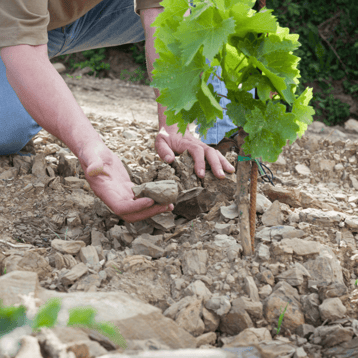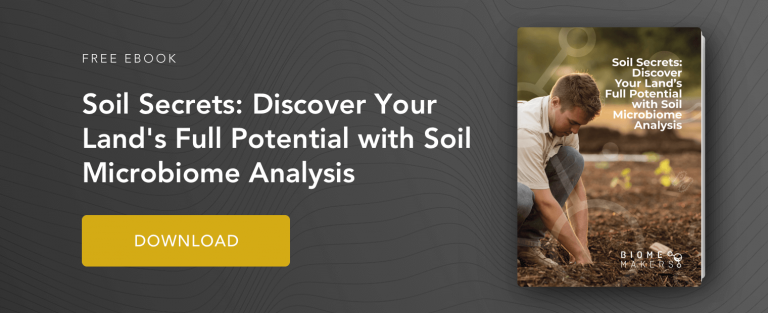Share this
Soil, Land, and Taste: The Terroir Connection
by Naz Hatay on 18/May/21
What is terroir?
The word “terroir,” which has a strong association with winemaking, actually means “soil” or “earth” in French. However, today it is primarily used to describe “the complete natural environment in which a particular wine is produced, including factors such as the soil, topography, and climate” (1). In the 1900's, French agronomists redefined the meaning of terroir, and among several definitions, Rouquette JL’s had the most holistic approach, which is: “The specificity of a given area, in seeking to valorize local agricultural production in the interest of local development. Terroir in this definition involved not only the natural environment, but the techniques used to establish local know-how and even the history of the socio-economic organization of the area”* (2). A broader definition from the International Organisation of Vine and Wine (OIV) describes terroir as a trait which “includes specific soil, topography, climate, landscape characteristics, and biodiversity features.” (3). To put the two definitions in the simplest form possible, terroir is the interactive ecosystem that includes climate, soil, vine rootstock, and cultivar.
Soil and Terroir
It is worth noting that, in the context of terroir, by "soil", we mean not only the soil characteristics or types but also soil microbiota and microorganisms that are essential for sustainable agriculture and desirable yield. Knowing that some scholars (Van Leeuwen and Seguin, 2006) also include the human factors such as viticulture (winegrowing) techniques and enological techniques as a part of this interactive ecosystem (4), it seems essential to iterate the microbial connection with terroir, as the microbial communities are impacted directly by agricultural management techniques.

Soil, Terroir, and Wine Making
In terms of the relationship between terroir and the cultivation of grapes, Deloire et al. describe this interconnectivity as “The terroir concept relates sensory attributes of wine to the environmental conditions in which the grapes are grown” (5). As soil greatly influences the whole process of winemaking from vine development to grape ripening, conditions related to soil i.e. soil temperature, water supply, and mineral supply make a significant effect on vine phenology (6). And last but not least, the level of water supply which has a direct impact on vine shoots and berry growth is vital to wine growing or viticulture. Limited water supply is critical, especially in producing high-quality red wines to reach a suitable grape composition (7). For example, “secondary metabolites, like polyphenols (anthocyanins, tannins) and aroma compounds or their precursors” as Deloire et al. explained, “are impacted in particular by vine water status” (8).
Aside from the soil temperature or water supply, the nutrients that vines absorb from soil, as in all agricultural crops, is essential to viticulture -which is affected directly by soil microorganisms as we have discussed in detail in our previous article “Soil, the diverse factory of life”. And among all nutrients, nitrogen plays a key role in wine production because it has a direct correlation to the yeast nutrient, and as a result, has a significant impact on wine fermentation. As it directly influences both fermentation kinetics and wine quality, nitrogen inevitably affects the final taste, too (9). Low nitrogen supply, for example, “stimulates the synthesis of polyphenols'' and can “impact certain aroma compounds in grapes and wines, like volatile thiols” (10). Moreover, the level of nitrogen supply also influences growth from crop level to vine vigor, and berry size (11). And due to its direct influence on vine vigor, low nitrogen supply -which is ideal for wine production- limits berry size and berry malic acid content, and increases sugar content and phenolic content (12). For instance, a moderate amount of nitrogen supply is desirable for red table wine production, as it is an important quality-enhancing factor (13).
Soil, Terroir, and Geology
Terroir includes factors such as landscape characteristics and topography, therefore geographic location certainly impacts both wine grape production and the wine itself. In other words, this link between land, soil, and wine quality implies that there is an association between the characteristics of a wine variety and the soil where it was cultivated. Hence, “quality wine grapes are grown on a diverse range of soils”, and “each soil type contributes its own characteristics and mouthfeel to give variety”(14). On the other hand, van Leeuwen takes a different stance which includes the physical properties of soil (i.e. texture, porosity, structure), and suggests that “the soil effect on terroir can be better explained by the physical properties of the soil and their consequences for root development on the regulation of water supply and nutrients to the vine” (15).
To summarize, the concept of “terroir” encompasses the key natural elements of climate, landscape characteristics, soil characteristics, and human factors such as vineyard management practices. It is important to acknowledge that this concept - which provides a link between “the sensory attributes of a wine and consumer expectations and the environmental conditions in which the grapes are grown” - has also evolved over the years.
And finally, as terroir directly impacts viticulture, anything it embraces plays a vital role in wine grape production, including but not limited to soil characteristics, and health.
Bibliography
1: Oxford Dictionary.
2: Deloire, Alain & Prévost, P. & Kelly, Mary. (2008). Unravelling the Terroir Mystique – an agro-socio-economic perspective. CAB Reviews Perspectives in Agriculture Veterinary Science Nutrition and Natural Resources. 3. 10.1079/PAVSNNR20083032.
*Translated by the authors of the paper above.
3: International Organisation of Vine and Wine (OIV)
https://www.oiv.int/public/medias/379/viti-2010-1-en.pdf
4: van Leeuwen, Cornelis & Seguin, Gerard. (2006). The concept of terroir in viticulture. Journal of Wine Research. 17. 1-10. 10.1080/09571260600633135.
https://www.researchgate.net/publication/236902064_The_concept_of_terroir_in_viticulture
5: Deloire, Alain & Prévost, P. & Kelly, Mary. (2008). Unravelling the Terroir Mystique – an agro-socio-economic perspective. CAB Reviews Perspectives in Agriculture Veterinary Science Nutrition and Natural Resources. 3. 10.1079/PAVSNNR20083032.
6: van Leeuwen, Cornelis & Roby, Jean-Philippe & Rességuier, Laure. (2018). Soil-related terroir factors: A review. OENO One. 52. 173-188. 10.20870/oeno-one.2018.52.2.2208.
https://www.researchgate.net/publication/326909810_Soil-related_terroir_factors_A_review
7: ibid. 6
8: Deloire, Alain & Prévost, P. & Kelly, Mary. (2008). Unravelling the Terroir Mystique – an agro-socio-economic perspective. CAB Reviews Perspectives in Agriculture Veterinary Science Nutrition and Natural Resources. 3. 10.1079/PAVSNNR20083032.
9: Antoine Gobert, Raphaëlle Tourdot-Maréchal, Céline Sparrow, Christophe Morge, Hervé Alexandre, Influence of nitrogen status in wine alcoholic fermentation, Food Microbiology,
Volume 83, 2019, Pages 71-85, ISSN 0740-0020, https://doi.org/10.1016/j.fm.2019.04.008.
10: Deloire, Alain & Prévost, P. & Kelly, Mary. (2008). Unravelling the Terroir Mystique – an agro-socio-economic perspective. CAB Reviews Perspectives in Agriculture Veterinary Science Nutrition and Natural Resources. 3. 10.1079/PAVSNNR20083032.
11: van Leeuwen, C., Roby, J.-P., & de Rességuier, L. (2018). Soil-related terroir factors: a review. OENO One, 52(2), 173–188. https://doi.org/10.20870/oeno-one.2018.52.2.2208
https://oeno-one.eu/article/view/2208
12: ibid. 11
13: Antoine Gobert, Raphaëlle Tourdot-Maréchal, Céline Sparrow, Christophe Morge, Hervé Alexandre, Influence of nitrogen status in wine alcoholic fermentation, Food Microbiology, Volume 83, 2019, Pages 71-85, ISSN 0740-0020, https://doi.org/10.1016/j.fm.2019.04.008.
14: P Clingeleffer, Terroir: The Application an Old Concept In Modern Viticulture, 2014. CSIRO Plant Industry, Glen Osmond, SA, Australia. Elsevier Inc.
https://www.sciencedirect.com/topics/agricultural-and-biological-sciences/terroir
15: P Clingeleffer, Terroir: The Application an Old Concept In Modern Viticulture, 2014. CSIRO Plant Industry, Glen Osmond, SA, Australia. Elsevier Inc.
https://www.sciencedirect.com/topics/agricultural-and-biological-sciences/terroir
Share this
- June 2025 (2)
- September 2024 (1)
- August 2024 (1)
- July 2024 (1)
- June 2024 (2)
- May 2024 (2)
- April 2024 (2)
- March 2024 (1)
- February 2024 (1)
- January 2024 (1)
- November 2023 (1)
- October 2023 (1)
- September 2023 (1)
- August 2023 (2)
- July 2023 (2)
- May 2023 (2)
- April 2023 (3)
- March 2023 (3)
- February 2023 (2)
- January 2023 (1)
- November 2022 (1)
- October 2022 (2)
- September 2022 (1)
- August 2022 (3)
- July 2022 (3)
- June 2022 (1)
- May 2022 (5)
- April 2022 (7)
- August 2021 (1)
- July 2021 (1)
- May 2021 (1)
- April 2021 (4)
- November 2020 (3)
- October 2020 (4)
- September 2020 (1)
- August 2020 (3)
- July 2020 (1)
- June 2020 (1)
- May 2020 (2)
